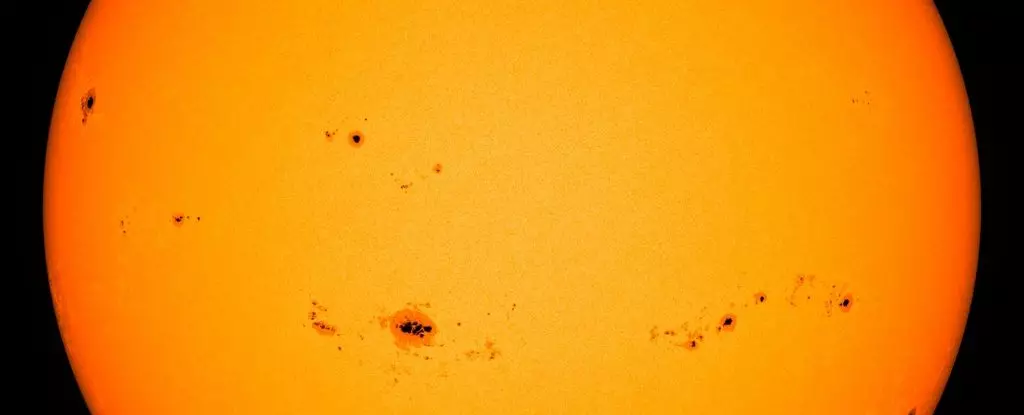As the cosmos continues its dance, a new chapter in solar activity is unfolding, igniting curiosity and concern on planet Earth. Agencies like NASA, NOAA, and the Solar Cycle Prediction Panel have announced that we are entering the solar maximum phase—a peak in the Sun’s roughly 11-year activity cycle. This period will be characterized by a marked increase in sunspots, solar flares, and coronal mass ejections (CMEs), all of which can have significant implications for both our technological infrastructure and the natural world around us.
With the announcement of solar maximum, we find ourselves at a crossroads where the Sun’s influence is felt more vividly. Solar maximum is synonymous with a period where sunspots proliferate on the Sun’s surface, resembling freckles on a sun-kissed arm. Sunspots are fundamental indicators of solar activity, arising from the Sun’s magnetic field becoming highly convoluted and localized. This tangling of magnetic fields inhibits the flow of hot plasma and results in cooler, darker patches on the Sun’s surface. The reversal of the Sun’s magnetic poles is also part of this cycle, where magnetic north and south swap positions, leading to a reduction in solar activity over time.
However, it is crucial to understand that while we comprehend the general dynamics of solar activity, predicting the exact timing and intensity of maximum phases remains elusive. Elsayed Talaat from NOAA aptly points out that just because the maximum activity phase is announced, it does not guarantee that peak activity has already occurred. The true peak of solar intensity often lags behind official designations, keeping scientists on their toes and reiterating the complexities of solar physics.
Delving deeper into the mechanics of solar cycles uncovers the mystery that lies at the core of our Sun. The solar dynamo, responsible for generating the Sun’s magnetic fields, remains an enigma. Michael Wheatland, a solar astrophysicist from the University of Sydney, underscores that our understanding of these magnetic processes is still incomplete. The investigations into sunspots and solar flares reveal that while we can observe and record activity, the underlying processes that govern these behaviors are not fully understood, positioning solar cycles among the exceptional unsolved puzzles in astrophysics.
Solar cycles exhibit significant variability, both in duration and intensity. Although the average cycle spans approximately 11 years, fluctuations are common, leading to cycles that may exceed or fall short of this average. Research does provide some insights that allow scientists to track the evolution of solar cycles using metrics such as the number of sunspots, but the unpredictable nature of these cycles adds a layer of complexity to forecasting future activity.
The ramifications of increased solar activity transcend mere academic interest; they hold direct implications for modern technology and life on Earth. Solar flares can disrupt radio communications, leading to blackouts that affect aviation and maritime operations. More significantly, coronal mass ejections can generate geomagnetic storms—a phenomenon that can wreak havoc on power grids, disrupt satellite operations, and interfere with communication systems. Geomagnetic storms can induce electrical currents that could lead to outages or infrastructure damage.
Yet, amid these potential disruptions, solar activity also gifts us with breathtaking natural displays. The interaction between solar particles and Earth’s upper atmosphere creates mesmerizing auroras, painting the skies with vibrant colors. This year, public enthusiasm for auroras has surged, attributed to the heightened solar activity that has made such spectacles more frequent.
Looking Ahead: What Do the Future Hold?
The current solar cycle has yielded more intense activity than initially predicted, although it has not reached extremes when compared to historical data. Notably, an X9.0 flare marked the most substantial release of energy in this cycle. Interestingly, some scientists had anticipated a stronger cycle despite official forecasts suggesting otherwise. Such discrepancies might refine our understanding of solar processes and enhance predictive models going forward.
As we embrace this solar maximum phase, the scientific community stands vigilant, prepared for both the challenges and opportunities that solar activity may present. With anticipation building for potential developments in solar research, we brace ourselves for what may lie ahead. Whether it is the beauty of auroras or the implications for our technological ecosystems, there is no doubt that our magnificent Sun continues to captivate our attention and fuel our quest for understanding.


Leave a Reply